Collection of materials relating to neuro-ophthalmology as part of the Neuro-Ophthalmology Virtual Education Library.
NOVEL: https://novel.utah.edu/
TO
- NOVEL978
Filters: Collection: "ehsl_novel_novel"
| Title | Creator | Description | Subject | ||
|---|---|---|---|---|---|
| 26 |
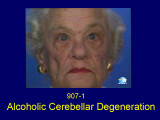 |
Alcoholic Cerebellar Degeneration | Shirley H. Wray, MD, PhD, FRCP | Slideshow describing condition. | Alcoholic Cerebellar Degeneration; Dysmetria; Gait Ataxia; Gaze Evoked Horizontal Nystagmus; Horizontal Gaze Evoked Nystagmus; Horizontal Saccadic Dysmetria; Horizontal Saccadic Hypermetria; Saccadic Pursuit; Square Wave Jerks |
| 27 |
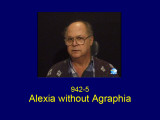 |
Alexia Without Agraphia | Shirley H. Wray, MD, PhD, FRCP | The patient is a 69 year old left handed man with a history of hypertension, insulin dependent diabetes mellitus and atrial fibrillation. Treated with coumadin, adjusted to keep the INR between 2 and 3. On the morning of admission he awoke at 4 a.m., sat momentarily on the side of the bed and then s... | Pure Alexia; Color Anomia; Right Homonymous Hemianopia; Alexia Without Agraphia; Infarct of the Left Visual Cortex and Splenium of the Corpus Callosum; Disconnection Syndrome; Occipital Infarct |
| 28 |
 |
Alexia Without Agraphia | Shirley H. Wray, MD, PhD, FRCP | Slideshow describing condition. | Alexia without Agraphia; Color Anomia; Disconnection Syndrome; Infarct of the Left Visual Cortex and Splenium of the Corpus Callosum; Pure Alexia; Right Homonymous Hemianopia |
| 29 |
 |
Alzheimer' s Disease | Shirley H. Wray, MD, PhD, FRCP | The patient is a 78 year old left handed woman with a diagnosis of a left parietal infarct in 1995, bilateral carotid artery stenosis and hypertension. She was first seen in August 1997 for evaluation of involuntary movements of the lower face in the setting of rapidly progressive dementia and was a... | Cerebral Cortex; Selective Saccadic Palsy - Acquired; Slow Initiation of Horizontal Saccades on Command; Slow Hypometric Horizontal Saccades; Supranuclear Saccadic and Pursuit Upgaze palsy; Slow Initiation of Horizontal Purusit Tracking a Slow Target; Positive Glabella Tap; Facial Tremor; Alzheimer'... |
| 30 |
 |
Alzheimer's Disease | Shirley H. Wray, MD, PhD, FRCP | Slideshow describing condition. | Alzheimer's Disease; Cerebral Cortex; CNS Degeneration; Facial Tremor; Positive Glabella Tap; Selective Saccadic Palsy - Acquired; Slow Hypometric Horizontal Saccades; Horizontal Purusit; Slow Initiation of Horizontal Saccades on Command; Supranuclear Saccadic and Pursuit Upgaze Palsy |
| 31 |
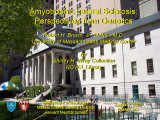 |
Amyotrophic Lateral Sclerosis | Robert H. Brown Jr, D.Phil, MD | Slideshow describing condition. | Bulbar Palsy; CNS Degeneration; Convergence Insufficiency; Familial Amyotrophic Lateral Sclerosis; Lou Gehrig's Disease; Saccadic Breakdown of Horizontal Pursuit; Slow Hypometric Horizontal Saccades; Superoxide Dismutase (SOD1) Gene; Supranuclear Paralysis of Up and Downgaze Degeneration |
| 32 |
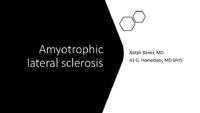 |
Amyotrophic Lateral Sclerosis (ALS) | Natali V. Baner, MD; Ali G. Hamedani, MD, MHS | PowerPoint providing an overview of the definition, clinical presentation and treatment of amyotrophic lateral sclerosis (ALS). | Amyotrophic Lateral Sclerosis (ALS) |
| 33 |
 |
Amyotrophic Lateral Sclerosis (Guest Lecture) | John Q. Trojanowski, MD | The patient is a 68 year old right handed retired air conditioner repair man who presented with impaired balance and slow walking. For about one year he had noted difficulty lifting his feet high enough when climbing the stairs. From that time on, his movements slowed and worsened so that he had dif... | Saccadic Initiation Deficit of Unilateral Horizontal Gaze; Complete Paralysis of Voluntary Horizontal Saccades on Command to Look Left; Inability to Make a Refixation Saccade on Command to a Target Held on the Left; Normal Voluntary Horizontal Saccadic Eye Movements to the Right; Impaired Pursuit; F... |
| 34 |
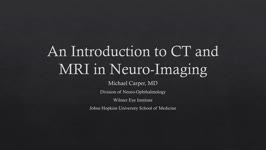 |
An Introduction to CT and MRI in Neuro-Imaging | Michael Carper, MD | A brief lecture covering basic neuro-imaging, including computed tomography (CT) and magnetic resonance imaging (MRI). | Computed Tomography (CT); Magnetic Resonance Imaging (MRI); Neuro-imaging |
| 35 |
 |
Anaesthesia for Eye Surgery and Associated Complications | Julie Smith, MBBS, FANZCA | Lecture covering commonly performed eye surgery and anaesthetic techniques. | Eye Surgery; Anesthesia |
| 36 |
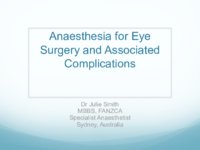 |
Anaesthesia for Eye Surgery and Associated Complications Slides | Julie Smith, MBBS, FANZCA | Lecture covering commonly performed eye surgery and anaesthetic techniques. | Eye Surgery; Anesthesia |
| 37 |
 |
Anatomic and Physiologic Basis for Gaze Stability | Ariel Winnick and Meagan Seay, DO | Diagram describing the anatomic and physiologic basis of gaze stability. | Gaze Stability |
| 38 |
 |
The Anatomic Course of Cranial Nerve IV | Divya Chauhan, MD | Overview of the intracranial course of the trochlear nerve. | Cranial Nerve IV; Trochlear Nerve; Anatomy |
| 39 |
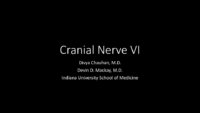 |
The Anatomic Course of Cranial Nerve VI | Divya Chauhan, MD | Overview of the intracranial course of the abducens nerve. | Cranial Nerve VI; Abducens Nerve; Anatomy |
| 40 |
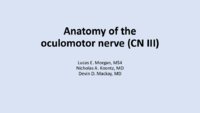 |
Anatomy of the Oculomotor Nerve (CN III) | Lucas E. Morgan, MS4; Nicholas A. Koontz, MD; Devin D. Mackay, MD | A detailed overview of the anatomic course of CN III, including a detailed pathway description and labeled MRI images, gross anatomy pictures, and structural models. | CN III; Third Cranial Nerve; Oculomotor Nerve; Anatomy; MRI |
| 41 |
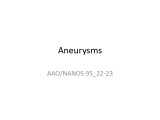 |
Aneurysms | AAO/NANOS - American Academy of Ophthalmology / North American Neuro-Ophthalmology Society | Aneurisms may result in neuro-ophthalmologic sign and symptoms by direct compression of the afferent or efferent systems or by the secondary effects of hemorrhage. Basilar aneurisms may result in ocular motor deficits such as a unilateral or bilateral third nerve palsy. | Aneurysm |
| 42 |
 |
Animated Lessons on the Neurology of Eye Movements and Pupillary Disorders | Dario Beltran, MD; Douglas Woo, MD; Elliot Frohman, MD, PhD; Steven L. Galetta, MD; Lewis E. Calver, MS; Kim Hoggatt Krumwiede, MA | This interactive training guide correlates clinical eye exams with lesion localization using illustrations, animations, and MRI's to enhance the learning of various common neuro-ophthalmologic lesions that are found in patients with Multiple Sclerosis (MS), stroke, tumor, or infection. Neurologists,... | Pupil Abnormalities; Ocular Movement Abnormalities; Diplopia |
| 43 |
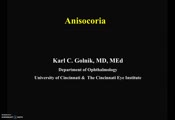 |
Anisocoria | Karl C. Golnik, MD | This is a narrated PowerPoint presentation that covers the common causes of anisocoria. | Pupil; Anisocoria |
| 44 |
 |
Anisocoria | NANOS | Anisocoria is a medical term for unequal pupil size. Normally our pupils are relatively the same size. While small differences in pupil size are normal and can even come and go ( physiologic anisocoria ), constant and significant differences in pupil sizes may be a sign of damage to the nerves that ... | Anisocoria; Patient Brochure |
| 45 |
 |
Anisocoria (French) | NANOS | Pupil in the right eye and left eye are not the same size. | Anisocoria; Patient Brochure |
| 46 |
 |
Anisocoria (German) | NANOS | Pupil in the right eye and left eye are not the same size. | Anisocoria; Patient Brochure |
| 47 |
 |
Anisocoria (Hebrew) | NANOS | Pupil in the right eye and left eye are not the same size. | Anisocoria; Patient Brochure |
| 48 |
 |
Anisocoria (Hungarian) | NANOS | The pupil in the right eye and left eye are not the same size. | Anisocoria; Patient Brochure |
| 49 |
 |
Anisocoria (Italian) | North American Neuro-Ophthalmology Society | The pupil in the right eye and left eye are not the same size. | Anisocoria; Patient Brochure |
| 50 |
 |
Anisocoria (Japanese) | NANOS | The pupil in the right eye and left eye are not the same size. | Anisocoria; Patient Brochure |
